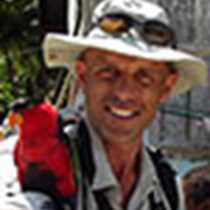Hornsund, Svalbard
After steaming south along the west coast overnight we entered the large fjord complex of Hornsund early in the morning. As we did so our first polar bear was sighted on shore. The ship approached as close as we were able to while we watched from the deck.
Our plan for the day was to make two landings within Hornsund. In the morning while hiking onshore at Gåshamna we found plentiful evidence of whaling that took place here several hundred years ago. Skulls and jawbones of bowhead whales were scattered on the shore. Whales were prey of some of the earliest visitors to Svalbard (English whalers in the 17th century). These whales were so easy to catch that they were nearly hunted to extinction. The population has been slow to recover and although there are usually a few sightings in Svalbard waters every year, they remain very rare. But even in death there is life, and around the whale bones were gardens of tiny Arctic flowers such as the tufted saxifrage, benefiting from nutrients from the ocean entering the soil from the remains of these ocean giants.
Later we went ashore at Gnålodden, at the foot of a towering cliff rising into the clouds, obscuring the tip of the 2,500 foot peak. Huge numbers of seabirds crowd the narrow rock ledges, in turn supporting a verdant flora fertilised by the steady rain of guano from above. Again we saw how nutrients from the ocean can be transferred to the land and produce a burst of life in an apparently barren landscape.
We also had a glimpse of the riches of the marine life – hints of the undersea riches courtesy of our Undersea Specialist who brought back images to the comfort of the lounge from a frigid dive in the fjord earlier in the day. And at the end of the day as we left the fjord and departed to the south we encountered further evidence of the rich waters of Svalbard in the shape of humpback whales. Migrants from warmer waters where they breed, these animals visit these waters to feed during the highly productive Arctic summer. While impacted by whaling, their numbers were never reduced as severely as bowhead whales and the population is showing positive signs of increasing.
After steaming south along the west coast overnight we entered the large fjord complex of Hornsund early in the morning. As we did so our first polar bear was sighted on shore. The ship approached as close as we were able to while we watched from the deck.
Our plan for the day was to make two landings within Hornsund. In the morning while hiking onshore at Gåshamna we found plentiful evidence of whaling that took place here several hundred years ago. Skulls and jawbones of bowhead whales were scattered on the shore. Whales were prey of some of the earliest visitors to Svalbard (English whalers in the 17th century). These whales were so easy to catch that they were nearly hunted to extinction. The population has been slow to recover and although there are usually a few sightings in Svalbard waters every year, they remain very rare. But even in death there is life, and around the whale bones were gardens of tiny Arctic flowers such as the tufted saxifrage, benefiting from nutrients from the ocean entering the soil from the remains of these ocean giants.
Later we went ashore at Gnålodden, at the foot of a towering cliff rising into the clouds, obscuring the tip of the 2,500 foot peak. Huge numbers of seabirds crowd the narrow rock ledges, in turn supporting a verdant flora fertilised by the steady rain of guano from above. Again we saw how nutrients from the ocean can be transferred to the land and produce a burst of life in an apparently barren landscape.
We also had a glimpse of the riches of the marine life – hints of the undersea riches courtesy of our Undersea Specialist who brought back images to the comfort of the lounge from a frigid dive in the fjord earlier in the day. And at the end of the day as we left the fjord and departed to the south we encountered further evidence of the rich waters of Svalbard in the shape of humpback whales. Migrants from warmer waters where they breed, these animals visit these waters to feed during the highly productive Arctic summer. While impacted by whaling, their numbers were never reduced as severely as bowhead whales and the population is showing positive signs of increasing.



